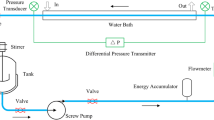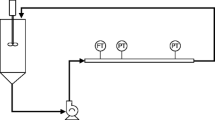Abstract
In order to develop turbulent drag-reducing technology by using an environmentally friendly additive in a water-transporting system, the drag reducing characteristics in a non-ionic surfactant (Oleyldimethylamineoxide, ODMAO) dilute aqueous solution flowing in a circular pipe of 5 mm diameter have been experimentally investigated with an air-driven fluid resistance test device. The rheological characteristics of the solution have also been examined by a rheometer with a cone-plate flow cell. The results show that the ODMAO solutions are drag-reducing when concentration is 400 ppm or higher, that the critical Reynolds number corresponding to the maximum drag reduction rate increases with both concentration and temperature, and that the maximum drag reduction rate can reach up to 70% in the straight pipe. At low shear rates, the shear viscosity of ODMAO solutions with a relatively high drag-reduction behaves similarly to Newtonian fluids; at above a certain critical shear rate, it is firstly shear-thickening, then shear-thinning. Such shear-rate-dependent characteristics of the shear viscosity are attributed to the different transitions of micellar network structure induced by different shear rates. Relaxation of shear stress after removing an applied constant shear rate at which the solution is in the SIS (shear-induced structure) state is found to be well expressed by a 2-step Maxwell model with a tail relaxation time much shorter than that for a drag-reducing cationic surfactant, which indicates that for the ODMAO solution, a viscoelasticity as strong as a drag-reducing cationic surfactant is not needed to realize turbulent drag-reduction.
Similar content being viewed by others
References
Indartono Y S, Usui H, Suzuki H. Hydrodynamics and heat transfer characteristics drag-reducing trimethylolethane solution and suspentions by cationic surfactant. J Chem Eng, 2006, 39(6): 623–632
Kawaguchi Y, Segawa T, Feng Z P, et al. Experimental study on drag-reducing channel flow with surfactant additives-spatial structure of turbulence investigated by PIV system. Int J Heat Fluid Flow, 2002, 23(3): 700–709
Suzuki H, Fuller G, Nakayama T, et al. Development characteristics of drag-reducing surfactant solution flow in a duct. Rheol Acta, 2004, 43(3): 232–239
Wei J J, Zakin J L, Kawaguchi Y, et al. Drag-reducing and heat transfer characteristics of a novel zwitterionic surfactant solution. Int J Heat Mass Transf, 2009, 52(15): 3547–3554
Gu W G, Wang D Z, Kawaguchi Y, et al. Experimental study on the characteristics of CTAC solution flow in the rectangular channel (in Chinese). Chin J Theor Appl Mech, 2010, 42: 312–318
Li F C, Kawaguchi Yu B. Experimental study drag-reduction mechanism for a dilute surfactant solution flow. Int J Heat Mass Transf, 2008, 51(4): 835–843
Warholic M D, Schmidt G M, Hanlatty T J. The influence of a drag reducing surfactant on a turbulent velocity field. J Fluid Mech, 1999, 388: 1–20
Hoffmann H, Rauscher A, Kalus J. Shear-induced transitions in micellar solutions. Prog Colloid Polym Sci, 1991, 84: 24–35
Lin Z, Zheng Y, Davis H T. Unusual effects of counterion to surfactant concentration ratio on viscoelasticity of a cationic surfactant drag reducer. J Non-Newt Fluid Mech, 2000, 93(2): 363–373
Lu B, Li X, Zakin J L, et al. A non-viscoelastic drag reducing cationic surfactant system. J Non-Newt Fluid Mech, 1997, 71(1): 59–72
Hu Y, Matthys F. Rheological and rheo-optical characterizationof shear-induced structure formation in a nonionic drag-reducing surfactant solution. J Rheol, 1997, 41(1): 151–166
Cho S H, Tae C S, Zaheeruddin M, et al. Effect of fluid velocity, temperature, and concentration of non-ionic surfactants on drag reduction. Energ Conv Manag, 2007, 48(5): 913–918
Tamano S, Itoh M, Yokota K. Drag-reducing effect of nonionic surfactant solutions (in Japanese). JSME B, 2009, 75(756): 1598–1607
Gurka R, Liberzon A, Hetsroni G. Characterization of turbulent flow in a flume with surfactants. J Fluid Eng, 2004, 126(6): 1054–1057
Chen H S, Chen D R, Wang J D, et al. Experimental study on the special shear thinning process of a kind non-Newtonian fluid. Sci China Ser E-Tech Sci, 2007, 50(2): 138–143
Suzuki H, Komoda Y, Usui H. Study on multi-structures of drag-reducing surfactant solution (in Japanese). JSME Fluid Eng Conf, Japan, Kanazawa, 2009, 11: 217–218
Author information
Authors and Affiliations
Corresponding author
Rights and permissions
About this article
Cite this article
Cai, S., Suzuki, H. & Komoda, Y. Drag-reduction of a nonionic surfactant aqueous solution and its rheological characteristics. Sci. China Technol. Sci. 55, 772–778 (2012). https://doi.org/10.1007/s11431-011-4728-y
Received:
Accepted:
Published:
Issue Date:
DOI: https://doi.org/10.1007/s11431-011-4728-y




